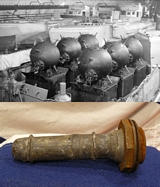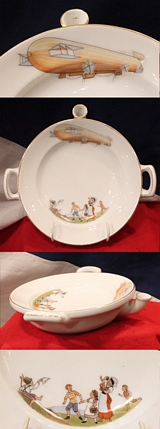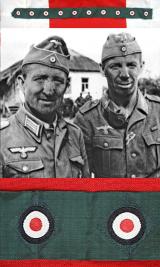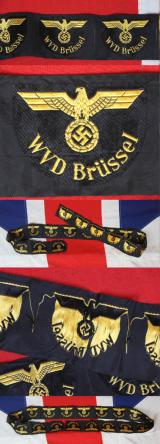Solid Silver Hallmarked L.Z.127 Graf Zeppelin Airship Aerospace Medal 1929 World Flight Issue
FRIEDRICHSHAFEN, STADT Medal 1929 (stamped by Josef Bernhart) on the 1st world flight of the LZ 127 "Graf Zeppelin". Busts of Zeppelin and Eckener l. Rev: Zeppelin. Beautiful patina. 36mm; 25g excellent condition Edge stamped hallmark: PREUSS. STATE COIN. SILVER 900
The around-the-globe flight of the German-built and -operated hydrogen-filled airship began in August 1929 at Lakehurst Naval Air Station in New Jersey, where it ended 21 days, five hours and 31 minutes later after covering some 20,651 miles in four legs.
Sponsored in part by Newspaper baron William Randolph Hearst, one of the worlds most influential newspaper owners and also one of the richest men in the world, in his day. His notoriety was also subject to a biographical movie loosely based on his life, Citizen Kane, directed by Orson Welles. The result of which caused W.R.Hearst to spend many years trying, and in many ways succeeding, to destroy Orson Welles' career.
Costs for the flight were subsidized by the transport of souvenir mail to and from the stops in Lakehurst, Friedrichshafen, Tokyo, and Los Angeles, and these pieces are highly collectible today. 1929. it was originally owned and run by Deutsche Luftschiffahrts-Aktiengesellschaft German Airship Transportation Corporation Ltd But in 1935 Reich Minister of Aviation, Hermann Göring insisted that a new agency be created to extend Party control over LZ Group. A personal rivalry between Göring and Propaganda Minister Joseph Goebbels also played a role. Deutsche Zeppelin-Reederei was therefore incorporated on 22 March 1935 as a joint venture between Zeppelin Luftschiffbau, the Ministry of Aviation, and Deutsche Lufthansa.
LZ 127 Graf Zeppelin was a German passenger-carrying, hydrogen-filled rigid airship which flew from 1928 to 1937. It was designed and built to show that intercontinental airship travel was practicable. Its operational history included several long flights, such as a polar exploration mission, a round-the-world trip, trips to the Middle East and the Americas (operating five years of regular passenger and mail flights from Germany to Brazil), and latterly being used as a propaganda vehicle for the ruling Nazi Party. The airship was withdrawn from service following the Hindenburg disaster.
Although to most this piece looks like a coin, in Germany and also in France, medals could come in the table medal variety, not ever meant to be worn but for display in a table cabinet or mounted and framed. Awarded for the same reason as a medal made to be only worn on the person, as all British medals are.
Photo in the gallery of the medals with the armband of the Ortsgruppenleiter, from whom the medals came from all sold seperately read more
225.00 GBP
Solid Silver Hallmarked L.Z.127 Graf Zeppelin Airship Aerospace Medal 1928 Issue
Zeppelin Aerospace medal in solid siver.
Silver medal 1928 (J. Bernhart) Airship LZ 127 "Graf Zeppelin". Half-length portraits of Zeppelin and Eckener side by side to the left / Airship over ocean. Edge stamped hallmark: PREUSS. STATE COIN. SILVER 900 FINE. 36 mm, 24.37 g Fine patina,
L.Z.127 Graf Zeppelin airship medals, one awarded in 1928 the other 1929. Sold separately, acquired with the Ortsgruppenleiter's armband taken as war souvenirs in 1945, sadly the name of the NSDAP Ortsgruppenleiter and his medals was not noted at the time.
LZ127 it was originally owned and run by Deutsche Luftschiffahrts-Aktiengesellschaft German Airship Transportation Corporation Ltd But in 1935 Reich Minister of Aviation, Hermann Göring insisted that a new agency be created to extend Party control over LZ Group. A personal rivalry between Göring and Propaganda Minister Joseph Goebbels also played a role.Deutsche Zeppelin-Reederei was therefore incorporated on 22 March 1935 as a joint venture between Zeppelin Luftschiffbau, the Ministry of Aviation, and Deutsche Luft Hansa.
LZ 127 Graf Zeppelin was a German passenger-carrying, hydrogen-filled rigid airship which flew from 1928 to 1937. It was designed and built to show that intercontinental airship travel was practicable. Its operational history included several long flights, such as a polar exploration mission, a round-the-world trip, trips to the Middle East and the Americas (operating five years of regular passenger and mail flights from Germany to Brazil), and latterly being used as a propaganda vehicle for the ruling Nazi Party. The airship was withdrawn from service following the Hindenburg disaster.
Photo in the gallery of the medals with the armband of the Ortsgruppenleiter, from whom the medals came from all sold seperately
Although to most this piece looks like a coin, in Germany and also in France, medals could come in the table medal variety, not ever meant to be worn but for display in a table cabinet or mounted and framed. Awarded for the same reason as a medal made to be only worn on the person, as all British medals are. read more
160.00 GBP
Historian Uncovers Graves of the Knights Templar in Staffordshire, Believed To Be One of the 'Most Nationally Important Discoveries' of its Kind
Graves belonging to members of the Knights Templar - a somewhat mysterious holy militia that sprang up in the 12th century - have been uncovered at an English village church in one of the 'most nationally important discoveries' of its kind.
The medieval order, which had chapters across Europe, including in Britain, were known for their role in the Crusades and as one of the Middle Ages' most powerful and wealthy religious organisations.
Historian Edward Spencer Dyas made the Da Vinci Code-style discovery of eight Knights Templar graves at St Mary's Church in Enville, Staffordshire.
In Dan Brown's novel, The Da Vinci Code, and the film of the same name starring Tom Hanks, Professor Robert Langdon delves beneath Rosslyn Chapel, in Scotland, in the hunt for Knights Templar treasure.
Mr Dyas now believes St Mary's could be one of the most nationally important Templar churches in the country because of its links to 'England's greatest knight' of the Middle Ages.
Mr Dyas' research led him to establish that St Mary's was built by Roger de Bermingham - a priest whose family owned all Enville land including Morfe, a medieval royal forest in neighbouring Shropshire.
Although records are missing it is clear the de Bermingham family built the Norman church at Enville, using Templar financing,' he added.
'Henry de Morfe, who held land owned by the de Berminghams, sold part of Morfe Forest to the Templars at this time, and the de Berminghams instated Roger de Bermingham as the first priest of St Mary's Church, Enville.'
It is for this reason that Mr Dyas believes the church was 'under the patronage of the Templars'.
William Marshal, the 1st Earl of Pembroke, was a jouster, warrior, diplomat and even twice de facto king who was the inspiration for Lancelot in medieval Arthurian tales and also drafted the Magna Carta.
Marshal died aged 73 in 1219 and was buried in Temple Church in London after being invested into the order of the Knights Templar on his deathbed.
But at St Mary's, the stained glass windows depict an array of coats of arms including one that belonged to Hugh Mortimer of Chelmarsh, who married Marshal's granddaughter.
There is little other explanation why there would be so many Templar graves at the quaint village church, although members of the group are believed to have attached themselves to churches dedicated to St Mary the Virgin. The church on the outskirts of the Black Country was built in the early 12th century at a time when the Templars were creating Preceptories - a type of monastery - around Britain.
Each of the graves he has uncovered features a Templar cross within double circles in a standard Templar design. One also includes a Crusader cross, suggesting the knight was both a Templar and a Crusader of the ancient military order.
At the foot of the same grave there's also a Templar Cross - a variation of the Jerusalem Cross - revealing the unknown knight had once been part of the Templar Order at Temple Mount, Jerusalem.
'I believe these discoveries make Enville one of the most nationally important churches in the country,' Mr Dyas said.
'That's due to its close links with William Marshall, who is considered of the greatest warriors England ever produced.
'But there is a mystery of why an European Templar is buried at Enville and why they were secretly so prominent there.'
The Crusades were a series of religious wars fought between 1095 and 1291, in which Christian invaders tried to claim the near East.
It's known that nobility led the Crusades, but historical records lack details of the ordinary soldiers who travelled to, lived and died in the near East.
The Crusades set the stage for several religious knightly military orders, including the Knights Templar, the Teutonic Knights, and the Hospitallers.
These groups defended the Holy Land and protected pilgrims travelling to and from the region.
We have a few original Templar and Templar period artefacts, which we show, and some are only a few hundred pounds. It represents an incredible opportunity to own a spectacular piece of world history.
If you wish to read the full story, the link is below;
https://www.dailymail.co.uk/sciencetech/article-12408493/The-real-life-Da-Vinci-Code-Historian-uncovers-graves-belonging-members-Knights-Templar-Staffordshire-one-nationally-important-discoveries-kind.html read more
Price
on
Request
After Over 50 Years Here I Am Just as Thrilled With Our Latest 5 Star Review as I Was The First Time, When We First Went Online Over 26 Years Ago In The Year 2 BG {Before Google}. Enjoy Your Online Experience
Not only are we extremely grateful for our fabulous reviews, 5 Star or otherwise, we are also extraordinarily delighted that all the people have gone to the effort to create such kind words, as we never, ever, request reviews from our visitors, it is all entirely and simply down to their kindness, and the valuable time and effort they take out of their lives in order to compose such compliments, within their reviews.
Here is just a sample of past 5 Star Reviews.
Brian
113 reviews·582 photos
Wow ,, this is my favourite shop of all time - my partner spent over an hour trying to get me out of the place - it’s a a sword collectors dream ,, you have to see this place to believe it Fantastic - you could spend all day in there and still miss something.
Response from the owner.
We were delighted for your visit, and thrilled you obviously enjoyed your time here, albeit more briefly than you might have liked. We hope you both make it down here to visit once again, many thanks and kindest regards, Mark
—————————
Emma Field
3 reviews·
I’ve purchased several items from this shop, my favourite being a katana. The brothers that own the shop are very informative and patient. I hope to return very soon. Highly recommend.
Response from the owner
Hi Emma, That is very kind of you to go to the bother to make such a nice review, it is much appreciated We very much look forward to your return, no purchase necessary of course, just to say hi! would be great enough. All the very best wishes, Mark
——————————-
Richard Dundas
15 reviews·2 photos
Incredible shop with an incredible selection of artefacts. There were so many amazing pieces in such a small space.
Response from the owner
Dear Richard, Thank you so much for your kind review and comments. It is always very much appreciated. see you again hopefully. Kind regards, Mark
—————————-
Neil Bolden
17 reviews
Bought a few items over the years. Guaranteed you are buying an authentic item. For my last purchase, Lanes Armoury went out of their way to locate an item l was looking for and l received it within 2 days of payment.
Response from the owner
Many thanks indeed for your most appreciated compliments, and we look forward to assisting you again in the future
———————————
Darcy Lawler
25 reviews·50 photos
Could spend absolutely hours wandering this tiny shop, so much history everytime you looked you saw something new. The two men working there were very friendly and knowledgeable, they were happy to answer any questions and tell stories about the items
Response from the owner
Thank you Darcy for your most kind and complimentary review. It is always a delight to us to know visitors to our shop have enjoyed their visit, it make all our efforts worthwhile. To take the time to review our family business online is also especially kind. Thank you once again.
——————————
John Anthony
Local Guide·77 reviews·53 photos
Great sword shop.
Response from the owner
Dear John, thank you so much for your compliment. It is always very pleasing to know that a local guide enjoyed their visit enough to leave a kind review. Many thanks once more
———————————
Curtis Ramsay
Response from the owner
Dear Curtis, i was delightful to see your Five Star review, it is much appreciated , and many thanks indeed. We are glad you enjoyed your visit
————————————
Chris Corfield
Local Guide·25 reviews
An absolutely amazing shop full of military history! The staff are knowledgeable and friendly. Thanks for your assistance and help with an appraisal.
Response from the owner
What a most kind compliment. we are delighted you enjoyed your visit, and we were most happy to assist you. You will be most welcome back anytime.
Thankyou
———————————-
John Anthony
Local Guide·77 reviews·53 photos
Great sword shop.
Response from the owner
Dear John, thank you so much for your compliment. It is always very pleasing to know that a local guide enjoyed their visit enough to leave a kind review. Many thanks once more
——————————-
steven gibson
1 review
We made our annual pilgrimage to this amazing shop this week, if we lived closer it would certainly be more often! The welcome we always receive from Mark + David is amazing, they are so passionate and knowledgeable about their stock and they will spend as much time as you need explaining the history and relevance of any item you wish to look at, so you know exactly what you are buying. You will be treated in the same way if you are browsing or buying. There have been comments previously about the high prices but when you are buying such a work of art you get what you pay for, and some of these items are museum quality. A well deserved 5*
Response from the owner
Dear Steven, it was delightful to see you both once more, and it was especially nice of you to take the time to make such a wonderful review. it is really very much appreciated. Looking forward to seeing you both next year, take care and many thanks indeed. Mark + David.
Post script, To be fair not everyone goes as high as 5*, as we simply cannot always be all things to all people, however hard we try, but be assured, every effort will be made by us to improve your rating on your next visit. For example we gained just 1 star from one of our oldest and most revered customers, because two years ago he simply he couldn’t get to grips with our ‘new and improved’’ website. So sorry Fred, we are trying our best to improve it for you! read more
Price
on
Request
A Most Rare Original WW2 German Hertz Horn MineTrigger
Made in lead alloy a tube that was filled with glass liners containing bio chromatic chemicals in order to break upon contact and ignite the mine in order to sink the allied ship.
Used on such as the German Type GZ (the German designation was UMA). It had a small charge of only 66 pounds of high explosive because it was intended as an anti-submarine mine. Anti-shipping mines had much larger charges.
Inert and completely safe. read more
145.00 GBP
A Very Good German 1900's & WW1 Porcelain Zeppelin Plate Warmer
Items made in Germany with representations of the pre war and WW1 Zeppelin airships are scarce and much sought after. This is a most unusual very early piece of very nice quality, but also a funtional piece of finest German porcelain. The best-known German strategic bombing campaign during World War I was the campaign against England, although strategic bombing raids were carried out or attempted on other fronts. The main campaign against England started in January 1915 using airships. From then until the end of World War I the German Navy and Army Air Services mounted over 50 bombing raids on the United Kingdom. These were generally referred to as "Zeppelin raids": although both Zeppelin and Sch?tte-Lanz airships were used, the Zeppelin company was much better known and was responsible for producing the vast majority of the airships used. Weather conditions and night flying conditions made airship navigation and therefore bombing accuracy difficult. Bombs were often dropped miles off target (one raid on London actually bombed Hull) and accurate targeting of military installations was impossible. The civilian casualties made the Zeppelins an object of hatred, and they were widely dubbed ?baby-killers?. With the development of effective defensive measures the airship raids became increasingly hazardous, and in 1917 the airships were largely replaced by aeroplanes.
Although the direct military effect of the raids was small, they caused widespread alarm, leading to the diversion of substantial resources from the Western Front and some disruption to industrial production. Concern about the conduct of defence against the raids, the responsibility for which was divided between the Admiralty and the Army, led to a parliamentary inquiry under Jan Smuts, whose report was to lead to the creation of the Royal Air Force on 1 April 1918. The defence organisation developed by the British was an important precursor of the fighter direction system that would prove vital in winning the Battle of Britain. The raids were also influential because they led to an overestimation of both the material and psychological effects of the bombing of cities.
Airships made about 51 bombing raids on England during the war. These killed 557 and injured another 1,358 people. More than 5,000 bombs were dropped on towns across Britain, causing ?1.5 million in damage. 84 airships took part, of which 30 were lost, either shot down or lost in accidents. Aeroplanes carried out 27 raids, dropping 246,774 lb (111,935 kg) of bombs for the loss of 62 aircraft, resulting in 835 deaths, 1972 injured read more
245.00 GBP
A Scarce Pattern of Imperial German 121st infantry Officers Sword XIII Royal Wurtemberg Corps
Bronze hilt with folding guard. Overall very nice condition and beautiful regimental markings to hilt and scabbard. Made by Gebruder Wayersberg of Solingen. Scabbard bottom section lacking. Potentially used by a Wurttemberg officer who knew or fought with another Wurttemberg officer at the same time, Erwin Rommel. On mobilization in 1914, the corps was subordinated to the 5th Army and saw action on the Western Front. It was transferred to the 6th Army during the Race to the Sea. In October 1914, the corps headquarters formed Corps Fabeck, which by the end of the month had become a provisional army group, commanding XV Corps, II Bavarian Corps and Corps Urach. In November, the XIII Army Corps was transferred from the 6th Army to the 9th Army on the Eastern Front. By 1916, the corps had returned to the Western Front and was subordinated to the 4th Army under Army Group Crown Prince Rupprecht. From April 1917 to March 1918, the corps commanded Group Caudry, another provisional command. In September 1918, it took over command of Group Ebene under Army Group Duke Albrecht of Württemberg, and commanded Group Ebene until war's end.
It was still in existence at the end of the war in Armee-Abteilung C, Heeresgruppe Gallwitz on the Western Front.
Württemberg mountain battalion
In 1915 a Württemberg mountain battalion was also formed, on drafts from the Württemberg line regiments, which became a part of the Alpenkorps division in 1917. This was the unit in which the young Erwin Rommel distinguished himself on the Romanian and Italian fronts, winning the Pour le Mérite (Imperial German equivalent of the Victoria Cross) at the Batlle of the Isonzo in 1917. Erwin Rommel was undoubtedly one of the finest generals of the Second World War, his strategic mind and patient approach led his men to victory after victory early in the war. But, while his fame and glory came as a General and Field Marshal, it was as a Lieutenant in the First World War that he earned his greatest honor.
Rommel started out the war in command of a reserve artillery company but immediately transferred to the 124th Wurtemberg Infantry regiment. By the middle of August 1914, he was in contact with the French, and showed his daring and genius in combat. The II Battalion, to which Rommel’s platoon was attached, halted at Bleid, a small French farming town. They sent out scouting parties, testing the various hedgerows and farms for French resistance.
Taking just three men from his platoon Rommel advanced to the edge of the town, where they found 15 French soldiers taking a nervous breakfast in the dense fog. Rather than retrieving his full platoon and assaulting, Rommel gave the order to open fire, and this four man party scattered the French troops, killing 5 of them. After receiving a stiff bout of rifle fire in response, he and his men returned to their platoon, then advanced with the rest of the battalion. read more
325.00 GBP
A Most Scarce Strip of 10 Heer EM/NCO Overseas M43 Cap Cockade Insignia
Made of a a machine embroidered cotton, this insignia is in very good un-issued condition! The colours are still vibrant! Features tri-colour national emblem. Perfect for any collection or display of German WW2 Very rare to find an un-issued strip of any form of German Bevo uniform insignia. A most rare discovery read more
375.00 GBP
An Amazing & Most Rare Un-Issued Fully Intact Strip of 18 Third Reich Reichsbahn Ärmeladler – WVD BrusselsArm Badges of the German Railways Armed Forces Traffic Directorate (WVD), Brussels Division
(Ärmeladler) of the WVD (Wehrmachtverkehrsdirektion) Brussels. WVD, " Wehrmacht Verkehrsdirektion" (Armed-forces Traffic-directorate),
Arm badge worn by personnel of the German Railways Armed Forces Traffic Directorate (WVD), Brussels Division. A machine woven, right facing eagle with outstretched wings and a wreathed, mobile swastika in its talons, positioned above the arching script, "WVD Brüssel." All of the threads are bright golden-yellow, against a half-moon. The insignia indicates service with the "Brüssel" division of the "Wehrmachtverkehrsdirektion.". Still on their original un-cut factory roll backing material.
WVD = Wehrmachtverkehrsdirektion
These badges were introduced in September 1941 superseding the German Railway cuff-titles, themselves only introduces some seven months previously, in February 1941. They were worn on the left upper arm of the uniform and usually cut or folded to produce a pointed or curved lower edge. The badges combined the German national eagle emblem above the initials of the relevant Railway Directorate, of which there were four (WVD, HVD, RBD & RVD), plus the specific Railway Division, which was usually based on large and important marshalling yards or railway areas. This branch of the Wehrmacht under the Nazi regime is responsible for controlling the operation of the national railways . It was created during the reorganization in 1937 of the Deutsche Reichsbahn into four directories.
It moved to Paris on June 21 , 1940 and the first contacts between SNCF and WVD took place on June 26 , 1940. The headquarters of the WVD was first in 36 of Avenue Kléber, then at 29,rue de Berri, in the 8 th arrondissement, near the Champs Elysées. It is the vice-president of the direction of the regional Reichsbahn of Hanover, Hans Münzer, who was named supreme commander (Kommandeur) of this authority of control of the French railways.
In August 1940, the operation of the network in occupied areas , outside Alsace-Lorraine, is transferred as a whole to the WVD located in Paris. A WVD is also installed in Brussels, which has jurisdiction over part of the North of France.
The SNCF retained ownership of the equipment which remained to it after the German requisitions, its trains were driven by French railway workers, but it was placed under the surveillance of WVD which subjected the personnel to German war laws and imposed the presence of 6500 German railway workers in stations, depots and operating sites responsible for ensuring the proper functioning of the company on site. Its goal is then to restart the French railway services in order to optimize its transport time, allow its use by the German forces, contribute to the German economy and among other things to continue to provide support to the ' invasion of North Africa . For these purposes, prisoners of war who have the skills of railway workers are released. It will then transit via French railways no less than 45 million tonnes of minerals between Italy and Germany Individual examples now sell for around £65 to £95 each read more
1245.00 GBP
A Pair Of French, Chassepot Rifle Sword Bayonets. 1870's
Very Good Chassepot Rifle Sword Bayonets. Stunning examples, with very good steel and brass, They could look super displayed just as we show them. The hilts have been polished as could the blades.
Its inventor was, Antoine Alphonse Chassepot, and it became the French service weapon in 1866. It was first used at the battlefield at Mentana, November 1867, where it inflicted severe losses on Garibaldi's troops. The event was reported at the French Parliament: "Les Chassepots ont fait merveille!", {The Chassepots did marvelous execution !} In the Franco-Prussian War (1870-1871) it proved greatly superior to the German Dreyse needle gun, outranging it by 2 to 1. Although it was a smaller caliber but the chassepot ammunition had more gunpowder and thus faster muzzle velocity. The Chassepots were responsible for most of the Prussian and other German casualties during the conflict. This is the most widely copied of all the sword bayonets. Many countries - including the United States, Egypt, Belgium, and Argentina - have manufactured or used very similar bayonets. The French model was designed to fit on the French Model 1866 Chassepot Rifled Infantry Musket (the musket was revolutionary in itself). It was manufactured from 1866 to about 1874 and was replaced by the French Model 1874 "Gras" Bayonet.
The bayonets are brass-hilted The crossguard is iron (steel) and has a screw-type tightening arrangement on the muzzle-ring. The lower quillon is a hooked "blade-breaker" type.
The blade is steel, single-edged, fullered (both sides), with a re-curved or "yataghan-shape." The blades marked on the back-edge (opposite the cutting edge) with the arsenal, month, and year of manufacture; this is done in engraved cursive fashion
Arsenals encountered may be such as Chatellerault, Mutzig, St. Etienne, Paris-Oudry, Tulle, and perhaps Steyr (not confirmed on the 1866). The French wars during the life-span of this bayonet were: French Intervention in Mexico (1861-1867);
Franco-Prussian War (July 19, 1870 - May 10, 1871)
French Indo-China (1873-1874, 1882-1883);
Sino-French War (1883-1885);
Madagascar Wars (1883-1885, 1895);
1st Mandingo-French War (1883-1886);
1st Dahomeyan-French War (1889-1990);
2nd Dahomeyan-French War (1892-1894);
Franco-Siamese War of (1893)
2nd Mandingo-French War (1894-1895);
Conquest of Chad (1897-1914);
3rd Mandingo-French War (1898);
Moroccan War (1907-1912);
The Wadai War (1909-1911);
World War I (early).
These bayonets were widely copied and used by many countries - including the United States, Belgium, and Germany. Many of the actual French-marked bayonets can be found with German manufactured blades. It is believed some of these were used during the American Civil War when many European arsenals were emptied of their surplus arms.
These bayonets are the French Model 1866 "Chassepot" Bayonet.
The crossguard are iron (steel) and with a "cock's comb" muzzle-ring finial. The lower quillon is a hooked "blade-breaker" type.
The blade is steel, single-edged, fullered (both sides), with a re-curved or "yataghan-shape." One blade is marked on the back-edge (opposite the cutting edge) with the arsenal, month, and year of manufacture; this is done in engraved cursive fashion. No scabbards read more
320.00 GBP











